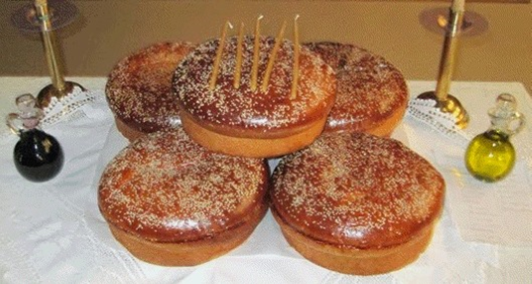ARTOKLASIA

Artoklasia - a Greek compound word from artos meaning bread, and klasis meaning breaking: “breaking of bread”. The Greek term derives from the very words used by the Evangelists in describing the Last Supper at which Christ “broke bread” and offered it to His disciples as His own Body. The Artoklasia Service is a brief service which includes hymns, petitions and prayers for health, well-being and strength to endure life’s difficulties. Five round loaves of sweet bread, together with wine, oil and wheat are offered by individual faithful as a sign of devotion for personal or family anniversaries, such as name days, and other occasions related to the lives of the Orthodox. At the conclusion of the Service, the loaves of bread are cut and distributed to the entire congregation. The Artoklasia Service is traditionally celebrated during the Vespers Service of a Great Feast Day, at the end of Orthros or at the conclusion of a regular Sunday Divine Liturgy. As the elements of bread, wine and oil, are found repeatedly in Scripture, the Orthodox Church uses them at various occasions. The five loaves are reminiscent of the five loaves that Jesus Christ blessed and by which the multitudes were fed (Matt. 14:13–21; Mark 6:31-44; Luke 9:10-17; John 6:5-14). In the Orthodox Church, bread continues to be highly valued not only as a basic food but also as the supreme symbol of the Body of Christ - for it is the bread which is changed by Consecration in the Liturgy into the Body of Christ. Christ has been repeatedly designated as the Bread of Life, and also as "living bread which came down from heaven ". ARTOKLASIA also symbolises and brings into practice the Agape meals (OrthoFlash, April 25, 2019) of the very early Christian communities.
ARTOCLASE
ARTOCLASE — Un mot grec composé de artos qui signifie pain, et klasis qui signifie rupture : « rompre le pain ». Ce terme dérive des mots mêmes utilisés par les évangélistes pour décrire la dernière Cène au cours de laquelle le Christ « rompit le pain » et le donna à Ses disciples comme son propre corps. Le SERVICE DE L’ARTOCLASE est un bref service qui comprend des hymnes, des pétitions et des prières pour la santé, le bien-être et la force de supporter les problèmes de la vie. Cinq miches de pain levé, des flacons de vin et d’huile d’olive et un plat de grains de froment sont offerts par des fidèles en guise de dévotion pour des anniversaires, des jours de fête, et d’autres occasions. À la fin du service, les miches de pain sont coupées et distribuées aux paroissiens. Le SERVICE DE L’ARTOCLASE est traditionnellement célébré pendant l’office des vêpres à l’occasion d’une Grande Fête, à la fin des Matines ou à la conclusion d’une Liturgie divine. Comme le pain, le vin et l’huile reviennent souvent dans les Écritures, l’Église orthodoxe s’en sert à diverses occasions. Les cinq miches nous rappellent les cinq pains que Jésus-Christ a bénis et qui ont nourri la foule (Mt 14, 13–21 ; Mc 6, 31-44 ; Lc 9, 10-17 ; Jn 6, 5-14). Dans l’Église orthodoxe, le pain est non seulement un aliment de base, mais il est aussi symbole suprême du Corps du Christ : le pain est changé par la Consécration en Corps du Christ. L’ARTOCLASE rappelle à l’ensemble des fidèles que Jésus est le « pain de vie », invisiblement et à jamais présent dans Son Église. Il symbolise aussi les agapes (OrthoFlash, le 25 avril 2019) des toutes premières communautés chrétiennes.
صلاة الخمس خبزات - الأرتوكلاسيا
تدعى صلاة الخمس خبزات ڊ الأرتوكلاسيا باللغة اليونانية وهي مشتقة من كلمتي "أرتوس" بمعنى "الخبز" و"كلاسيس" بمعنى "كَسْر" أي " كسر الخبز" . يشتقُّ المصطلح اليوناني من الكلمات ذاتها التي استخدمها الإنجيليون في وصف العشاء السري الذي كسر فيه السيد المسيح الخبز وقدمه لتلاميذه على أنه جسده (قائلا "هذا هو جسدي"). إن خدمة الخمس خبزات (الأرتوكلاسيا) هي عبارة عن صلاة قصيرة تتضمن التراتيل والطلبات والصلوات من أجل الصحة والرفاه والقوة لتحمل صعوبات الحياة. حيث تٌقدم فيها خمسة أرغفة مستديرة من الخبز الحلو بالإضافة إلى النبيذ والزيت والقمح من قبل المؤمنين كدليل على التقوى، بشكل فردي كتقدمة عن الأعياد الشخصية أو العائلية كعيد الشفيع ومناسبات أخرى متعلقة بحياة الأرثودوكسيين. حيث يتم في ختام الخدمة تقطيع الخبزات وتوزيعها إلى كافة الرعية. وعادة ما تقدم صلاة الخمس خبزات خلال خدمة صلاة الغروب للأعياد الكنسية الكبيرة أو في نهاية صلاة السحر أو في نهاية القداس الإلهي في أيام الآحاد. تٌذكر عناصر الخبز والنبيذ والزيت تكراراً في الكتابات المقدسة وتستخدمها الكنيسة الأرثودوكسية في مناسبات مختلفة. تذكرنا الأرغفة الخمسة بالأرغفة الخمسة التي باركها يسوع المسيح والتي تم بها إطعام الجموع (متى 14: 13-21 ومرقس 6: 31-44 ولوقا 9: 10-17 ويوحنا 6: 5-14). هذا ولا يزال الخبز يحظى بتقدير كبير في الكنيسة الأرثودوكسية ليس كغذاء أساسي فحسب وإنما كرمز أسمى لجسد المسيح – لأنه الخبز الذي يتحول إلى جسد المسيح من خلال التكريس في الليتورجيا. وقد تكررت الإشارة إلى المسيح على أنه خبز الحياة وكذلك على أنه "الخبز الحي الذي نزل من السماء". خدمة كسر الخبز أيضاً ترمز وتستحضر بممارستها موائد المحبة (أغابي) التي كانت تقيمها جماعات المسيحيين الأوائل (أرثوفلاش 25 نيسان 2019) .